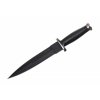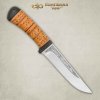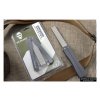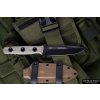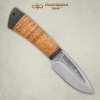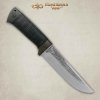Steel Z90 (Z90CDV18) is a high-carbon stainless alloy created by the French metallurgical industry, which has high hardness, wear resistance and ductility. It is actively used in the knife industry. It is classified as a high-quality steel for making knives in the budget and mid-range segment.
Specifications:
Z90 is a corrosion-resistant chromium steel produced by the French Association Francaise de Normalization (AFNOR). This alloy, like its many analogues, including the domestic steel 95 × 18, is widely popular and is actively used in knife production.
The characteristics of the Z90 depend entirely on the quality of the hardening. With the correct technology, it is possible to achieve optimal performance for creating cutting tools. So, the hardness of the metal is in the range of 57-59 HRC, which is the most suitable value at which a high level of strength is achieved without loss of elasticity, some manufacturers bring this value to 60-62 HRC, but then there is a great risk of making the alloy too brittle.
Steel has undoubted advantages:
- Good resistance to corrosion and chemical processes due to its high chromium and vanadium content.
- Excellent toughness is an important characteristic, which means that the blade will not break even under strong mechanical stress, for example, if it is thrown into wood or struck against another metal.
- Affordable cost, allowing the Z90 to be attributed to the middle price segment, while the quality of this steel is an order of magnitude higher than that of many competitors - an important plus in modern realities.
- The alloy composition includes various alloying additives that optimally balance its characteristics.
- Hardness 57-59 HRC is almost ideal, it combines strength and flexibility.
- The Z90 makes all-round knives that, thanks to their properties, are able to cope with any daily task.
But there are also disadvantages:
- Metal processing is rather difficult due to its high hardness. It is not easy to sharpen a knife - a significant disadvantage at home, however, it dulls much longer.
- Sometimes, depending on the manufacturer, it turns out that the Z90 composition in excess can be burdened with phosphorus and sulfur, which negatively affect all positive properties.
- Many blades made of this steel have increased fragility, so it is better not to take risks and not use them for working with very hard materials.
Chemical composition
Composition of Z90 CDV18 steel in percent:
| C | Cr | Mn | Mo | Ni | P | Si | S | V |
| 0.9-1.1 | 16-18 | - | 0.6-1 | - | 0.03 | 1.0 | 0.025 | 0.1 |
- Carbon affects the hardness of the metal, but its high content makes the structure brittle;
- Chromium determines the resistance of the alloy to corrosion processes;
- Molybdenum increases hardenability and has a positive effect on wear resistance;
- Phosphorus and sulfur are harmful additives used in production technology; outside the norm, they significantly reduce the characteristics of steel;
- Vanadium increases strength, service life and toughness;
- Silicon removes unnecessary oxygen bubbles from the composition, making its structure homogeneous.
Analogs
One of the closest analogues of the Z90 in terms of its properties and chemical composition is the domestic steel 95X18. Most of the Russian blacksmiths and large manufacturers, for example, "Zlatoust" actively use it in the production of knives, which is not at all surprising. Blades made of 95X18 have a number of positive properties:
- high level of wear resistance;
- increased strength;
- hardness;
- neutral reaction to aggressive media.

